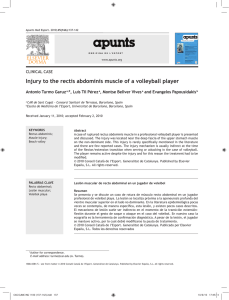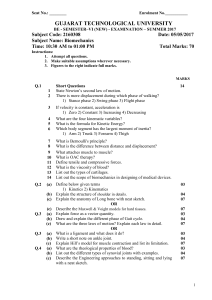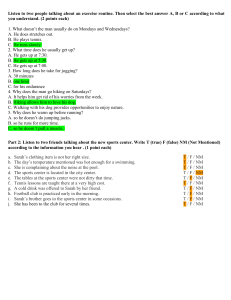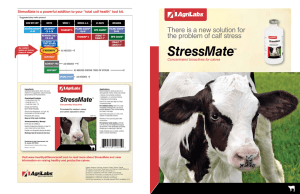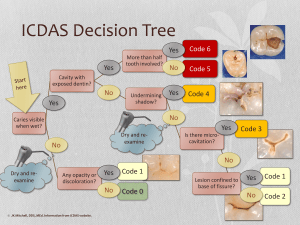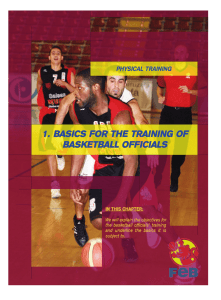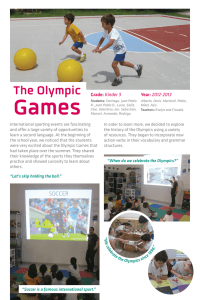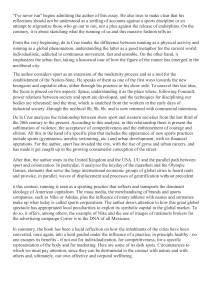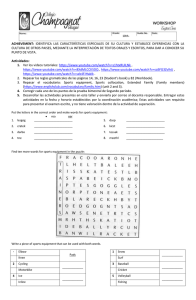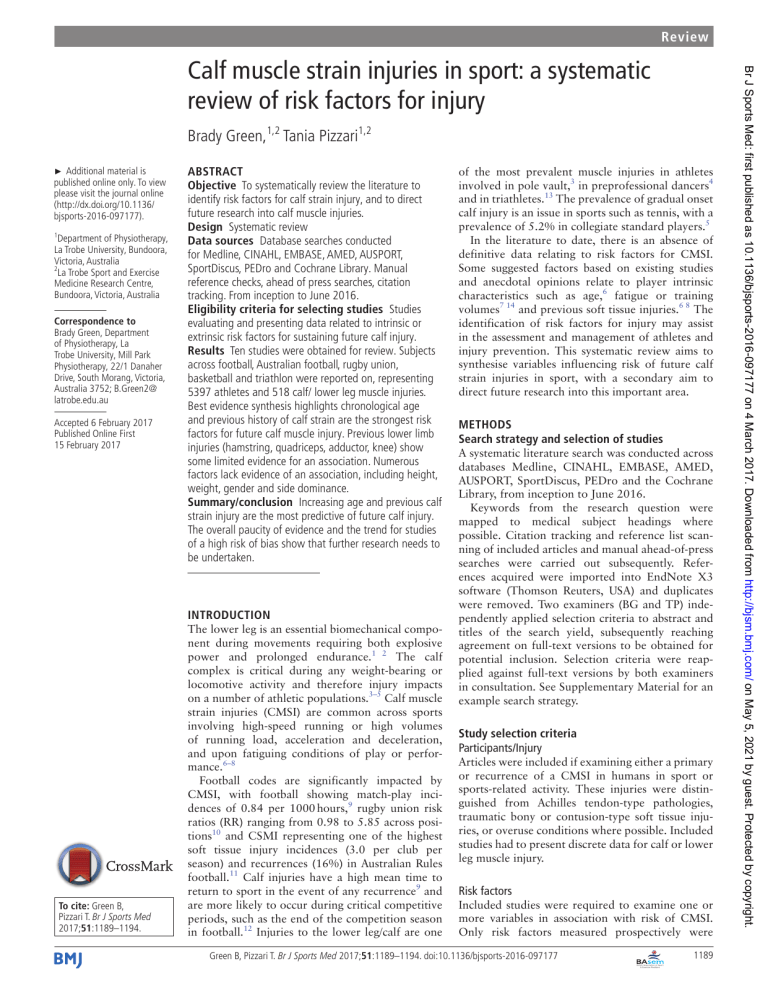
Review Brady Green,1,2 Tania Pizzari1,2 ►► Additional material is published online only. To view please visit the journal online (http://d x.doi.o rg/10.1136/ bjsports-2016-097177). 1 Department of Physiotherapy, La Trobe University, Bundoora, Victoria, Australia 2 La Trobe Sport and Exercise Medicine Research Centre, Bundoora, Victoria, Australia Correspondence to Brady Green, Department of Physiotherapy, La Trobe University, Mill Park Physiotherapy, 22/1 Danaher Drive, South Morang, Victoria, Australia 3752; B.Green2@ latrobe.edu.au Accepted 6 February 2017 Published Online First 15 February 2017 ABSTRACT Objective To systematically review the literature to identify risk factors for calf strain injury, and to direct future research into calf muscle injuries. Design Systematic review Data sources Database searches conducted for Medline, CINAHL, EMBASE, AMED, AUSPORT, SportDiscus, PEDro and Cochrane Library. Manual reference checks, ahead of press searches, citation tracking. From inception to June 2016. Eligibility criteria for selecting studies Studies evaluating and presenting data related to intrinsic or extrinsic risk factors for sustaining future calf injury. Results Ten studies were obtained for review. Subjects across football, Australian football, rugby union, basketball and triathlon were reported on, representing 5397 athletes and 518 calf/ lower leg muscle injuries. Best evidence synthesis highlights chronological age and previous history of calf strain are the strongest risk factors for future calf muscle injury. Previous lower limb injuries (hamstring, quadriceps, adductor, knee) show some limited evidence for an association. Numerous factors lack evidence of an association, including height, weight, gender and side dominance. Summary/conclusion Increasing age and previous calf strain injury are the most predictive of future calf injury. The overall paucity of evidence and the trend for studies of a high risk of bias show that further research needs to be undertaken. Introduction To cite: Green B, Pizzari T. Br J Sports Med 2017;51:1189–1194. The lower leg is an essential biomechanical component during movements requiring both explosive power and prolonged endurance.1 2 The calf complex is critical during any weight-bearing or locomotive activity and therefore injury impacts on a number of athletic populations.3–5 Calf muscle strain injuries (CMSI) are common across sports involving high-speed running or high volumes of running load, acceleration and deceleration, and upon fatiguing conditions of play or performance.6–8 Football codes are significantly impacted by CMSI, with football showing match-play incidences of 0.84 per 1000 hours,9 rugby union risk ratios (RR) ranging from 0.98 to 5.85 across positions10 and CSMI representing one of the highest soft tissue injury incidences (3.0 per club per season) and recurrences (16%) in Australian Rules football.11 Calf injuries have a high mean time to return to sport in the event of any recurrence9 and are more likely to occur during critical competitive periods, such as the end of the competition season in football.12 Injuries to the lower leg/calf are one of the most prevalent muscle injuries in athletes involved in pole vault,3 in preprofessional dancers4 and in triathletes.13 The prevalence of gradual onset calf injury is an issue in sports such as tennis, with a prevalence of 5.2% in collegiate standard players.5 In the literature to date, there is an absence of definitive data relating to risk factors for CMSI. Some suggested factors based on existing studies and anecdotal opinions relate to player intrinsic characteristics such as age,6 fatigue or training volumes7 14 and previous soft tissue injuries.6 8 The identification of risk factors for injury may assist in the assessment and management of athletes and injury prevention. This systematic review aims to synthesise variables influencing risk of future calf strain injuries in sport, with a secondary aim to direct future research into this important area. Methods Search strategy and selection of studies A systematic literature search was conducted across databases Medline, CINAHL, EMBASE, AMED, AUSPORT, SportDiscus, PEDro and the Cochrane Library, from inception to June 2016. Keywords from the research question were mapped to medical subject headings where possible. Citation tracking and reference list scanning of included articles and manual ahead-of-press searches were carried out subsequently. References acquired were imported into EndNote X3 software (Thomson Reuters, USA) and duplicates were removed. Two examiners (BG and TP) independently applied selection criteria to abstract and titles of the search yield, subsequently reaching agreement on full-text versions to be obtained for potential inclusion. Selection criteria were reapplied against full-text versions by both examiners in consultation. See Supplementary Material for an example search strategy. Study selection criteria Participants/Injury Articles were included if examining either a primary or recurrence of a CMSI in humans in sport or sports-related activity. These injuries were distinguished from Achilles tendon-type pathologies, traumatic bony or contusion-type soft tissue injuries, or overuse conditions where possible. Included studies had to present discrete data for calf or lower leg muscle injury. Risk factors Included studies were required to examine one or more variables in association with risk of CMSI. Only risk factors measured prospectively were Green B, Pizzari T. Br J Sports Med 2017;51:1189–1194. doi:10.1136/bjsports-2016-097177 1189 Br J Sports Med: first published as 10.1136/bjsports-2016-097177 on 4 March 2017. Downloaded from http://bjsm.bmj.com/ on May 5, 2021 by guest. Protected by copyright. Calf muscle strain injuries in sport: a systematic review of risk factors for injury Review Study type Epidemiological or descriptive studies reporting incidences only, intervention studies, non-systematic reviews, case studies and opinion articles were not included. Studies were required to be available in full text, from peer-reviewed sources and written in the English language. Unpublished data and conference abstracts were not included because of the lack of rigorous methodological appraisal. Data collection and analysis Data extraction Data extraction was undertaken with a focus on sports activity, participant characteristics, specific extrinsic or intrinsic risk factors examined and CMSI injury outcomes. Methods of analysis were also examined in terms of injury diagnosis, study durations, overall results (including statistical techniques used and their specific findings) and general heterogeneity between variables measured in different studies. Non-blinded reviewers (BG and TP) extracted data independently, including means, SD, HR, RR and OR. Other variables extracted from included studies related to match or activity characteristics. Data analysis, risk of bias assessment and best evidence synthesis Because of the small number of studies available, and heterogeneity of data sets and variables measured, meta-analyses were not performed. Instead, a qualitative synthesis of results was primarily undertaken, with any probability and risk data (HR, OR and RR) presented in the results of this review taken directly from included studies. Paucity of data did not permit meta-analysis or further computation of other statistical relationships. A risk of bias assessment was carried out by two independent reviewers (BG and TP) using a modified version of the Quality in Prognosis Studies (QUIPS) tool, as previously outlined15 16 and also conducted in a recent muscle-related systematic review of the literature.17 Six subheadings were used to appraise different study design elements and potential sources of bias, with a number of criteria within each category, each scoring a ‘yes’ or ‘no.’ A subheading was considered to have high risk of bias if less than 75% of the items within it achieved a score of ‘yes.’ The subheading was otherwise considered to have a low risk of bias if more than 75% of the criteria received a score of ‘yes.’ The overall risk of bias for a study was then calculated according to how many of the six subheadings were deemed to be high risk, which has been advocated for in the literature previously.18 A study was considered to be of low overall risk of bias if at least five of the six categories were satisfied, along with requiring a low risk for the subheading relating to outcome measurement (item 4). All discrepancies in results of risk of bias assessment between independent reviewers (BG and TP) were compared and discussed until full agreement was reached. A copy of the modified QUIPS can be found in online supplementary appendix 1. A best evidence synthesis was then undertaken since many of the studies presented heterogeneous study design, statistical methods or overall quality. This combined approach enables clarification of the strength of evidence around a particular measured variable.19 A best evidence synthesis has been described in the literature previously,19 20 and employed in muscle-related systematic reviews to qualitatively analyse according to five hierarchical criteria aligned to study quality and clinical results presented17 21: 1. Strong evidence: consistent findings in more than one highquality study. Figure 1 Search flow diagram. 1190 Green B, Pizzari T. Br J Sports Med 2017;51:1189–1194. doi:10.1136/bjsports-2016-097177 Br J Sports Med: first published as 10.1136/bjsports-2016-097177 on 4 March 2017. Downloaded from http://bjsm.bmj.com/ on May 5, 2021 by guest. Protected by copyright. acceptable, unless retrospective analysis evaluated non-modifiable risk factors. This was to avoid the limitations of retrospective analysis for identifying whether measured relationships were the result of, or predisposed to, the recorded injury. Data relating only to match-play versus training injury incidences were also considered irrelevant to the aims of the review. Review Characteristics of included studies Study Study design Sample and/or sport Number/rate of CMSI or ‘lower leg’ Risk factors Bengtsson et al (2013)7 Prospective cohort 27 European professional football (soccer) teams from 10 countries—621 individual players CMSI Match load, between match recovery, Acute calf muscle injury 11 seasons RR=1.13/1000 hours match characteristics diagnosed and recorded on match exposure electronic injury registry by club medical staff Brooks and Kemp Prospective cohort (2011)10 Specific outcome Length of tracking 899 players from 14 English NA Premiership rugby union clubs Playing position, match-related injury Acute calf muscle strain injury 4 seasons diagnosed and reported by club medical staff Hägglund et al (2013)8 Prospective cohort 1401 players from 26 soccer CMSI (n=306) clubs across 10 countries Previous calf muscle injury, previous other muscle injuries, age, stature, body mass, playing position Acute calf muscle injury as 2001–2010 diagnosed by club medical staff seasons Orchard et al (2014)11 Prospective cohort 1607 elite Australian Rules football players CMSI (n=140) Age, height, weight, BMI, month, environmental conditions, calf injury within 8 weeks, previous calf injury beyond 8 weeks, older players (age>23), past quadriceps injury beyond 8 weeks Calf strain injury assessment and diagnosis by club medical staff, with or without imaging investigations Carling et al (2015)14 Prospective observational 25 professional soccer players from one club Calf IRR=4.1/1000 hours match exposure Fixture congestion and match characteristics Calf muscle injury as diagnosed 6 seasons and recorded by club (2009–2015) Nilstad et al (2014)23 Prospective cohort 173 elite female Norwegian ‘Leg/foot’ injuries soccer players from 12 (n=28) teams Previous knee injury, age, BMI, lower extremity strength, dynamic balance, knee biomechanics and laxity, foot posture (pronation) Calf injuries (as captured leg/ foot injury data) 1 season McKay et al (2001)25 Prospective cohort Elite and recreational Australian basketball players—190 players ‘Calf/anterior leg’ injuries (n=12) Gender, level of competition Calf muscle injury (as captured in ‘Calf/Anterior Leg' injuries data) 2 seasons Faude et al (2006)22 Prospective cohort 143 German national league soccer players over 12 teams ‘Lower leg’ injuries (n=19) Anthropometric measurements, playing position, injury history, training and match exposure time Calf muscle injury (as captured in ‘lower leg’ data pool) 1 season Korkia et al (1994)13 Prospective study 155 British triathletes ‘Lower leg’ injuries (n=13) Training history, injury history Calf muscle injuries (as reported 1 season in ‘lower leg’ injury) as selfreported questionnaire ‘Thigh and calf’ injuries 41.3/1000 hours Training load and injury data according to competition phases Calf muscle injury (as described 2 seasons in combined ‘Thigh and Calf’ data) Prospective Gabbett and Domrow (2007)24 cohort 183 subelite rugby league players 1992–1999 competition seasons BMI, body mass index; CMSI, calf muscle strain injury; IRR, injury rate ratio; NA, not applicable; RR, rate ratio. 2. Moderate evidence: consistent findings in one high-quality study and one or multiple low-quality studies, or by consistent findings in multiple low-quality studies. 3. Limited evidence: findings presented from a single study only (high-quality or low-quality study). 4. Conflicting evidence: findings across more than one study that does not have consistent results. 5. No evidence: no randomised controlled trials or nonrandomised controlled trials available for assessment. Results Search results The initial search yielded a total of 1188 studies after removal of duplicates. Application of selection criteria to titles and abstracts of the initial yield resulted in full-text versions of 47 studies being acquired for further analysis. Application of criteria to full-text articles left eight studies remaining to be included. Citation tracking, ahead-of-press searches and reference scanning resulted in another potential 10 articles, of which two met the inclusion and exclusion criteria (figure 1). Reasons for exclusion are included in online supplementary appendix 2. Description of the included studies A total of 10 studies were included for the purposes of this systematic review, accounting for a total participant pool of more than 5000 participants across football,7 8 14 22 23 Australian Rules football,6 rugby union,10 24 basketball25 and triathlon.13 Data extraction was performed on all of the 10 included studies. A detailed description of the study characteristics is presented in table 1. Risk of bias assessment and best evidence synthesis Seven studies7 10 13 14 22 24 25 were scored with a high risk of bias, while the other remaining three studies6 8 23 were determined to have a low risk of bias (table 2). Authors retained agreement on all scoring and bias assessment results. Key areas of bias across the 10 included studies were related to study attrition, study confounding variables and measurement of prognostic factors. All studies presented simple univariate statistical methods, while four offered some relevant information from multivariate models.6 8 23 25 For full details of the best evidence synthesis, see table 3 below. Evaluation of risk factors Chronological age Strong evidence exists for an association between increased age and future calf strain, measured in Australian football and football athletes6 8 (table 3). Two large prospective studies with low risk of bias found significant associations across both univariate and multivariate analyses.6 8 Green B, Pizzari T. Br J Sports Med 2017;51:1189–1194. doi:10.1136/bjsports-2016-097177 1191 Br J Sports Med: first published as 10.1136/bjsports-2016-097177 on 4 March 2017. Downloaded from http://bjsm.bmj.com/ on May 5, 2021 by guest. Protected by copyright. Table 1 Review Individual player characteristics Risk of bias assessment Study Moderate evidence was found for no association between limb dominance and calf muscle or lower leg muscle injury, across one high risk and one low risk of bias study.8 22 Limited evidence for no association between player stature and future CMSI was highlighted in a single study with low risk of bias, while strong evidence of no relationship was presented across a pair of low risk of bias studies reporting on player mass.6 8 There may however be a limited association in terms of the specific measure of body mass index (BMI) and calf strain risk.6 Player height and gender showed limited evidence for no association in low-risk and high-risk studies, respectively6 25 (table 3). Risk of bias Potential risk of bias item 1 2 3 4 5 6 Bengtsson + et al (2013)7 − + + − + High Brooks and Kemp (2011)10 + − + + − + High Hägglund et al (2013)8 + + + + − + Low Orchard (2001)6 + − + + + + Low Carling et − al (2015)14 + − + + + High Nilstad et + al (2014)23 + − + + + Low McKay et − al (2001)25 + − − − + High Faude et al + (2006)22 − + + − + High Korkia et al − (1994)13 − − − − − High Gabbett and Domrow (2007)24 + − + + + − High Table 3 Results of the best evidence synthesis Match characteristics, fatigue and playing schedule The precompetition or preseason period showed limited evidence for higher risk of calf injury compared with other phases of the season, examined in a single high risk of bias study.24 During the competitive season, a pair of high risk of bias studies together provides moderate evidence for no association between periods of greater playing schedule congestion or less between-match recovery and sustaining a CMSI.7 14 Examining playing standard or competition level offered only limited findings of no association in a single high-risk study.25 The actual position played by the athletes in rugby and football codes provides conflicting evidence of no relationship8 10 (table 3). History of previous CMSI Two low risks of bias studies provide strong evidence for history of previous calf muscle injury and future risk6 8 (table 3). Data N Univariate Low risk of bias High risk of bias Multivariate Association with risk (↑\↓\=) Low risk of High risk bias of bias Best evidence synthesis Presence of Level of association evidence Risk factors Chronological age 3008 Sex 190 Limb dominance 1544 ↑6 8 Yes 25 =25 No Limited 22 =8 22 No Moderate 68 8 6 Strong Player stature 1401 8 =8 No Limited Player body mass/weight 3008 68 =6 8 No Strong BMI 1607 6 ↑6 Yes Limited Player height 1607 6 =6 No Limited Preseason period 183 24 ↑24 Yes Limited Shorter between-match recovery/congested playing schedule 621 7 14 =7 14 No Moderate Level of competition 190 Playing position 2300 8 25 =25 No Limited 10 =8 10 No Conflicting Previous calf muscle strain injury 3008 Previous adductor 1401 68 ↑6 8 Yes Strong 8 ↑8 Yes Previous quadriceps Limited 1607 6 ↑6 Yes Limited Previous knee 173 23 ↑23 Yes Limited Previous hamstring 1401 8 ↑8 Yes Limited Previous ‘lower leg, knee, thigh, ankle/foot and back’ 155 ↑13 Yes Limited Limited 13 Temperature 1607 6 =6 No Evaporation in previous 7 days 1607 6 =6 No Limited Rainfall in previous 7 days 1607 6 =6 No Limited Rainfall on game day 1607 6 =6 No Limited Month of year 1607 6 =6 No Limited ↑↑, association with future calf muscle strain; ↓, association with lower risk for future calf muscle strain; =, no association with future calf muscle strain; BMI, body mass index. 1192 Green B, Pizzari T. Br J Sports Med 2017;51:1189–1194. doi:10.1136/bjsports-2016-097177 Br J Sports Med: first published as 10.1136/bjsports-2016-097177 on 4 March 2017. Downloaded from http://bjsm.bmj.com/ on May 5, 2021 by guest. Protected by copyright. Table 2 Review History of other previous lower limb injury Four studies presented data relating to other previous injury and future calf or lower leg injury in triathletes, football and Australian Rules athletes6 8 13 23 (table 3). Across a number of low risk of bias studies, some limited evidence exists for an association between previous adductor, previous hamstring, previous quadriceps, and previous knee injury and future CMSI.6 8 23 Previous ‘lower leg, knee, thigh, ankle/foot and back’ injury in the preceding 12-month period was identified by a single high risk of bias study and classified as having a limited association.13 Other extrinsic variables There was limited evidence for no association between temperature, evaporation in the previous week, game-day rainfall, rainfall in the previous week and month of the year with sustaining a calf or lower leg muscle injury.6 Discussion This review established that the strongest risk factors for CMSI are increased player age and any history of previous CMSI. There may also be limited evidence that other lower limb soft tissue or joint injuries (hamstring, quadriceps, adductor, knee) predispose athletes to calf or lower leg muscle injuries, along with being in the preseason period or the player having an increased BMI. This review also identified a number of factors showing no association with future calf strain. Strong evidence for no association was found for absolute player mass, along with moderate evidence for no relationship with reduced betweenmatch recovery or schedule congestion. A number of individual player characteristics (height, stature, side dominance, gender) and playing standard further failed to highlight an association, as did any environmental factor examined. There seems to be some conflicting evidence regarding positional demands in football and rugby codes, across multiple studies of both low and high risks of bias. Overall, the small number of studies and variables available for synthesis together with the lack of homogeneity in data presented and methodological approaches to outcome measurement limits the conclusions that can be drawn. In addition, the quality of the included studies was variable. Risk of bias assessment showed that there were clear discrepancies in terms of overall study quality, which influenced the strength and number of definitive findings when synthesising the evidence. Confirmation of chronological age and previous muscle injury as strong risk factors for future muscle strain is not surprising given these non-modifiable risk factors have been implicated in risk for hamstring,26 groin8 27 and quadriceps6 strain injuries. Increasing age as a risk factor also bears relevance to previous literature detailing age-related neuromuscular maladaptations and loss in skeletal muscle tissue quality and function.28 29 Age-related structural tissue changes are linked with progressive loss of important neuromuscular attributes such as power outputs or rate of force development,29 and disruptions to motor unit discharge rates.30 In the event of previous injury, maladaptive responses have been tracked following hamstring31–33 and ACL34 35 injuries, affecting factors relating to strength,31–35 neurology31 32 34 and tissue architecture.32 33 35 Local structural tissue alterations are an important maladaptation to consider, particularly given their association with tendon continuum presentations in the Achilles.36 37 Literature has previously established the importance of gastrocnemius fascicle length in sprinting athletes, and therefore maximal power outputs over fast velocities,1 with both a strong and statistically significant correlation with maximal sprinting speed.1 2 This may also highlight the importance of tissue extensibility or flexibility, of which long fascicular lengths are a purported requisite, despite no direct evidence exploring its role in calf strain injury risk. More recent studies into the hamstring strain injuries have underlined this structural necessity in the hamstring complex.38 The presence of shorter fascicle lengths in the biceps femoris below a certain threshold resulted in significantly elevated risk for future hamstring muscle strains.38 Local factors relating to calf muscle fascicle length, pennation angle, cross-sectional area and tissue quality may therefore be worthwhile when evaluating risk of injury compared with more global and less specific variables such as stature, height and weight. These areas provide some direction for future calf research, along with recent studies that have presented significant associations between measures of different strength qualities and soft tissue injury—namely eccentric strength39 and strength endurance40 for sustaining future hamstring muscle strains. Related works have also identified an important association between greater levels of eccentric strength and increasing fascicle lengths as able to ameliorate risk of non-modifiable risk factors of age and previous injury history,38 which is particularly relevant given that these were the only two risk factors with strong evidence in this review. Rehabilitation and conditioning practices could hope to mirror these findings, along with recent literature detailing the importance of long-term training chronicity in building athlete preparedness and injury resilience.41 Implementing interventions for eliciting adaptation to fascicle lengths and eccentric capacity in the calf complex however require scientific validation and further research. Green B, Pizzari T. Br J Sports Med 2017;51:1189–1194. doi:10.1136/bjsports-2016-097177 What is already known on this topic? ►► The calf complex is essential to lower limb mechanics during locomotive and weight-bearing tasks. ►► Calf muscle strain injuries (CMSI) are a common soft tissue injury across numerous team and individual sporting codes. ►► Literature in this area is limited, and a systematic analysis establishing a group of possible risk factors, and any interrelationships between these factors, has not been performed to date. What this study adds? ►► Despite a limited number of studies available, data analysis provides evidence for age and previous CMSI as the strongest risk factors for calf strain injury. ►► Previous adductor, hamstring, quadriceps or knee injury may also influence likelihood of injury. ►► Variables relating to individual player characteristics and environmental descriptors do not seem to be related to future calf or lower leg strain. ►► This review highlights the factors that need further study in the scientific literature, with future direction of research similar to that undertaken recently in the field of hamstrings. 1193 Br J Sports Med: first published as 10.1136/bjsports-2016-097177 on 4 March 2017. Downloaded from http://bjsm.bmj.com/ on May 5, 2021 by guest. Protected by copyright. were presented using univariate and multivariate approaches, with one study further dichotomising data to highlight an elevated risk for future calf strain if a calf muscle injury had been experienced in the preceding 8-week period (RR=8.94, 95% CI 5.1 to 15.66).6 Review Conclusion History of a previous calf muscle strain and increasing player age provide the strongest evidence for future calf strain risk. Factors such as player weight, height, gender and side dominance can be considered to lack evidence of an association with sustaining a calf muscle injury. A number of other measures and variables may also have an influence on risk; however, additional research is required to build the evidence base in this area, and to offer some further understanding of risk. Contributors BG and TP made equal contributions to the work. Both authors gave permission for the final version to be submitted. Competing interests None declared. Provenance and peer review Not commissioned; externally peer reviewed. © Article author(s) (or their employer(s) unless otherwise stated in the text of the article) 2017. All rights reserved. No commercial use is permitted unless otherwise expressly granted. References 1 Abe T, Kumagai K, Brechue WF. Fascicle length of leg muscles is greater in sprinters than distance runners. Med Sci Sports Exerc 2000;32:1125–9. 2 Abe T, Fukashiro S, Harada Y, et al. Relationship between sprint performance and muscle fascicle length in female sprinters. J Physiol Anthropol Appl Human Sci 2001;20:141–7. 3 Rebella G A Prospective Study of Injury Patterns in Collegiate Pole Vaulters. Am J Sports Med 2015;43:808–15. 4 Luke AC, Kinney SA, D’Hemecourt PA, et al. Determinants of injuries in young dancers. Med Probl Perform Art 2002;17:105–12. 5 Colberg RE, Aune KT, Choi AJ, et al. Incidence and prevalence of musculoskeletal conditions in collegiate tennis athletes. JMST 2015;20:137–44. 6 Orchard JW. Intrinsic and extrinsic risk factors for muscle strains in Australian football. Am J Sports Med 2001;29:300–3. 7 Bengtsson H, Ekstrand J, Hägglund M. Muscle injury rates in professional football increase with fixture congestion: an 11-year follow-up of the UEFA champions league injury study. Br J Sports Med 2013;47:743–7. 8 Hägglund M, Waldén M, Ekstrand J. Risk factors for lower extremity muscle injury in professional soccer: the UEFA injury study. Am J Sports Med 2013;41:327–35. 9 Carling C, Le Gall F, Orhant E. A four-season prospective study of muscle strain reoccurrences in a professional football club. Res Sports Med 2011;19:92–102. 10 Brooks JH, Kemp SP. Injury-prevention priorities according to playing position in professional rugby union players. Br J Sports Med 2011;45:765–75. 11 Orchard J, Seward H, Orchard J. AFL injury report. Australian Football League (AFL) 2014;2014:1–20. 12 Mallo J, Dellal A. Injury risk in professional football players with special reference to the playing position and training periodization. J Sports Med Phys Fitness 2012;52:631–8. 13 Korkia PK, Tunstall-Pedoe DS, Maffuli N. An epidemiological investigation of training and injury patterns in British triathletes. Br J Sports Med 1994;1994:191–6. 1194 14 Carling C, McCall A, Le Gall F, et al. The impact of short periods of match congestion on injury risk and patterns in an elite football club. Br J Sports Med; Published Online First 18 December 2015. 15 Hayden JA, Côté P, Bombardier C. Evaluation of the quality of prognosis studies in systematic reviews. Ann Intern Med 2006;144:427–37. 16 Hayden JA, van der Windt DA, Cartwright JL, et al. Assessing bias in studies of prognostic factors. Ann Intern Med 2013;2013:280–6. 17 Schut L, Wangensteen A, Maaskant J, et al. Can clinical evaluation predict return to sport after acute hamstring injuries? A systematic review. Sports Med 2016; Published Online First 18 October 2016. 18 Iles RA, Davidson M, Taylor NF, et al. Systematic review of the ability of recovery expectations to predict outcomes in non-chronic non-specific low back pain. J Occup Rehabil 2009;19:25–40. 19 Slavin RE. Best evidence synthesis: an intelligent alternative to meta-analysis. J Clin Epidemiol 1995;48:9–18. 20 van Tulder M, Furlan A, Bombardier C. Updated method guidelines for systematic reviews in the cochrane collaboration back review group. J Spine 2003;28:1290–9. 21 Reurink G, Goudswaard GJ, Tol JL, et al. Therapeutic interventions for acute hamstring injuries: a systematic review. Br J Sports Med 2012;46:103–9. 22 Faude O, Junge A, Kindermann W, et al. Risk factors for injuries in elite female soccer players. Br J Sports Med 2006;40:785–90. 23 Nilstad A, Andersen TE, Bahr R, et al. Risk factors for lower extremity injuries in elite female soccer players. Am J Sports Med 2014;42:940–8. 24 Gabbett TJ, Domrow N. Relationships between training load, injury, and fitness in sub-elite collision sport athletes. . J Sport Sci 2007;25:1507–19. 25 McKay GD, Goldie PA, Payne WR, et al. A prospective study of injuries in basketball: a total profile and comparison by gender and standard of competition. J Sci Med Sport 2001;4:196–211. 26 Freckleton G, Pizzari T. Risk factors for hamstring muscle strain injury in sport: a systematic review and meta-analysis. Br J Sports Med 2013;47:351–8. 27 Engebretsen AH, Myklebust G, Holme I, et al. Intrinsic risk factors for groin injuries among male soccer players: a prospective cohort study. Am J Sports Med 2010;38:2051–7. 28 Mitchell WK, Williams J, Atherton P, et al. Sarcopenia, dynapenia, and the impact of advancing age on human skeletal muscle size and strength: a quantitative review. Front Physiol 2012;3:1–18. 29 Aagaard P, Magnusson PS, Larsson B, et al. Mechanical muscle function, morphology, and fiber type in lifelong trained elderly. Med Sci Sports Exerc 2007;39:1989–96. 30 Dalton BH, Jakobi JM, Allman BL, et al. Differential age-related changes in motor unit properties between elbow flexors and extensors. . Acta Physiol 2010;200:45–55. 31 Opar DA, Williams MD, Timmins RG, et al. Knee flexor strength and bicep femoris electromyographical activity is lower in previously strained hamstrings. J Electromyogr Kinesiol 2013;23:696–703. 32 Fyfe JJ, Opar DA, Williams MD, et al. The role of neuromuscular inhibition in hamstring strain injury recurrence. J Electromyogr Kinesiol 2013;23:523–30. 33 Timmins RG, Shield AJ, Williams MD, et al. Architectural adaptations of muscle to training and injury: a narrative review outlining the contributions by fascicle length, pennation angle and muscle thickness. Br J Sports Med (Published Online First: 27 January 2016). 34 Opar DA, Serpell BG. Is there a potential relationship between prior hamstring strain injury and increased risk for future anterior cruciate ligament injury? Arch Phys Med Rehabil 2014;95:401–5. 35 Timmins RG, Bourne MN, Shield AJ, et al. Biceps femoris architecture and strength in Athletes with a previous anterior cruciate ligament reconstruction. Med Sci Sports Exerc 2016;48:337–45. 36 Kjaer M, Langberg H, Heinemeier K, et al. From mechanical loading to collagen synthesis, structural changes and function in human tendon. Scand J Med Sci Sports 2009;19:500–10. 37 Rees JD, Maffulli N, Cook J. Management of tendinopathy. Am J Sports Med 2009;37:1855–67. 38 Timmins RG, Bourne MN, Shield AJ, et al. Short biceps femoris fascicles and eccentric knee flexor weakness increase the risk of hamstring injury in elite football (soccer): a prospective cohort study. Br J Sports Med (Published Online First: December 2015). 39 Bourne MN, Opar DA, Williams MD, et al. Eccentric knee flexor strength and risk of hamstring injuries in Rugby Union: a prospective study. Am J Sports Med 2015;43:2663–70. 40 Freckleton G, Cook J, Pizzari T. The predictive validity of a single leg bridge test for hamstring injuries in australian rules football players. Br J Sports Med 2014;48:713–7. 41 Gabbett TJ. The training-injury prevention paradox: should athletes be training smarter and harder? Br J Sports Med 2016;50:273–80. Green B, Pizzari T. Br J Sports Med 2017;51:1189–1194. doi:10.1136/bjsports-2016-097177 Br J Sports Med: first published as 10.1136/bjsports-2016-097177 on 4 March 2017. Downloaded from http://bjsm.bmj.com/ on May 5, 2021 by guest. Protected by copyright. The small number of studies and variables explored in this review provides some direction in the topic of CMSI. However, the overall paucity of homogenous data and overall study quality influence the quality of conclusions that can be made. There is also the potential for a publication bias given that only published literature was included for the purposes of review, and a language bias associated with inclusion of English-language only publications. Findings from this systematic review should be considered with understanding that there are limitations in both the quality of evidence and the amount of evidence available. Clinical interpretation of findings should consider that there are potentially other influences on risk for future CMSI than are mentioned or examined in detail in this systematic review.
